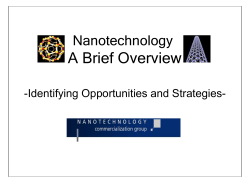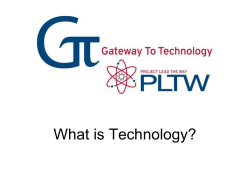
Nanotechnology Research at Georgia Tech David S. Gottfried, Ph.D. Senior Research Scientist
Nanotechnology Research at Georgia Tech David S. Gottfried, Ph.D. Senior Research Scientist Nanotechnology Research Center Nanotechnology Definition Nanotechnology is the understanding and control of matter at dimensions between approximately 1 and 100 nanometers, where unique phenomena enable novel applications. Encompassing nanoscale science, engineering, and technology, nanotechnology involves imaging, measuring, modeling, and manipulating matter at this length scale. National Nanotechnology Initiative 25 Federal Agencies 13 with R&D Budget >$1.5 Billion (2007) What is a Nanometer? 1 meter (m) : 1 nanometer (nm) 1 nanometer/sec 70-80,000 nm diameter What is a Nanometer? • C-C bond length = 1.5 Å = 0.15 nm • DNA diameter = 2 nm • Hemoglobin = 6 nm • Ribosome = 20 nm • Influenza virus = 100 nm Ancient Nanotechnology The Lycurgus Cup (Late Roman, 4th Century AD) British Museum National Nanotechnology Infrastructure Network (NNIN) Mission: Enable rapid advancements in science, engineering and technology at the nanoscale by efficient access to nanotechnology infrastructure. Approach: A network of shared open facilities distributed throughout the country that will enable the full creative abilities of the nanoscale user community to emerge. GT NRC: Application of nanofabrication to bioengineering and biomedicine Lead on K-12 education for the network NRC Users Georgia Tech Users External Academic and Gov’t. Users Auburn, Clark Atlanta, Clemson, Emory, Harvard, Louisiana State Univ., Mercer, MIT, Norfolk State, Purdue, Univ. of Florida, Univ. of South Carolina, Univ. of Tennessee, Univ. of Texas, University System of Georgia, Vanderbilt, College of Wooster Centers for Disease Control, Oak Ridge National Lab, WrightPatterson AFB, NASA, USDA External Industry Users Applied Biosystems, Axion Biosystems, Biotronics, CardioMEMS, CibaVision, CIS Biotech, Greatbatch, HewlettPackard, Icon Interventional, Intel, Kimberly-Clark, MEMSCap, Milliken and Co., nGimat, Open Cell, Sandisk, Sematech, St. Judes Medical, STS Microsystems, Qualtre, Voxtel 689 Total Users (2010) 36% External NRC Research Facilities Pettit Microelectronics Building 8,500 sq. ft. cleanroom facility Additional laboratory space with characterization tools > 100 fabrication and characterization tools Marcus Nanotechnology Building 30,000 sq. ft. cleanroom 1/3 life sciences (BSL-1 & BSL-2) 2/3 physical sciences (semiconductor) >50 new tools Georgia Tech NRC Toolset Lithography Optical, Electron Beam, Imprint Substrate Treatment Etch Processing Thermal Processing Metallization Deposition CVD, Biomolecules Packaging Microscopy/Imaging Surface Characterization Particle Characterization Georgia Tech Nano Research Areas Academic Schools Research Topics College of Science • Biology • Chemistry and Biochemistry • Earth and Atmospheric Science • Physics College of Engineering • Biomedical (Joint with Emory) • Civil and Environmental • Chemical and Biomolecular • Electrical and Computer • Mechanical • Materials Science • Polymer, Textile and Fiber College of Architecture School of Public Policy Georgia Tech Research Institute • • • • • • Nanoelectronics (Microelectronics) Optics/Photonics Sensors MEMS/BioMEMS/NEMS Nanostructures Nanomaterials Nanotechnology Approaches • Top-down • Nanofabrication • MEMS, NEMS • Nanolithography • Nanoimprinting • Atomic force microscope modifications • Dip-pen nanolithography • Focused ion beam • Nanomaterials • Carbon nanotubes • Semiconductor and oxide nanowires and nanobelts • Quantum dots • Gold nanoparticles and nanorods • Graphene • Bottom-up • DNA-based well-defined structures • Molecular self-assembly • Self-assembled monolayers • Molecular imprinting • Atomic layer deposition Unique Phenomena: Optical Properties Imaging and Diagnostics Quantum Dots for Cellular Imaging S. Nie (BME) Photonic Devices Chemical/Biological Sensing using an Optical Resonator A. Adibi (ECE) Unique Phenomena: Electronic Properties Nanoelectronics Graphene Transistors W. de Heer (Physics) Printed Electronics Flexible Organic Field-Effect Transistors B. Kippelen (ECE) Unique Phenomena: Mechanical Properties MEMS Devices Self-Powered Nanowire Devices Z.L. Wang (MSE) Nanomaterials Dry Adhesive Based on Carbon Nanotubes Z.L. Wang (MSE) Nanostructures Perspiration NanoPatch for Electronics Cooling A. Fedorov and Y. Joshi (ME) Unique Phenomena: Biological Interactions Devices and Diagnostics EndoSure® Wireless AAA Pressure Measurement System M. Allen and J. Yadav (CardioMEMS) Drug Delivery and Therapeutics Magnetic Nanoparticles for Extraction of Ovarian Cancer Cells J. McDonald (Biology) and Z. Zhang (Chem. and Biochem.) Regenerative Medicine Molecular Imprinting for Cellular Adhesion A. Garcia (BME) Nanomedicine at Georgia Tech Prof. Gang Bao (BME) Nanomedicine Center for Nucleoprotein Machines Novel Applications 2007 was a pivotal year: • Industry R&D $6.6 Billion • Government R&D $6.2 Billion Project on Emerging Nanotechnologies http://www.nanotechproject.org/ • • • • • >1300 Nano Products (212 when started in 2006) 587 companies $147 Billion (2007) 60% in health/fitness category Nano-silver is most common nano-ingredient (25%) Commercial Applications • Electronic Devices • Biotechnology and Medical Devices • Clothing and Textiles • Consumer Products Nokia Morph Concept Education and Outreach • Nano@Tech Seminar Series • NanoFANS (Focusing on Advanced NanoBio Systems) • Technical User Forums • Research Experience for Undergraduates/Teachers (REU/RET) • NanoCamp Summer Programs • Student/Teacher Visits and Programs Commercialization Mr. Tom O’Brien CEO Dr. David Safranski Post-Doctoral Scientist For more information David Gottfried, Ph.D. Senior Research Scientist Institute for Electronics and Nanotechnology Georgia Institute of Technology (404) 894-0479 dsgottfried@gatech.edu
© Copyright 2025





















